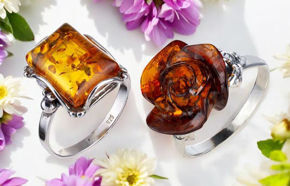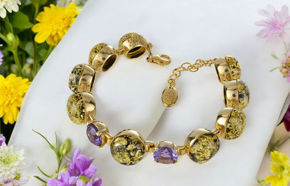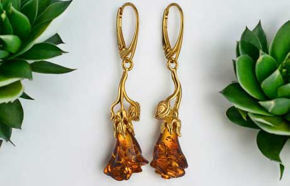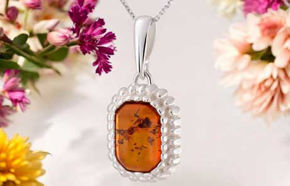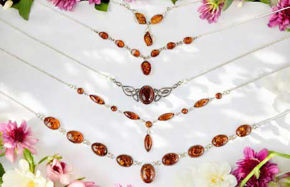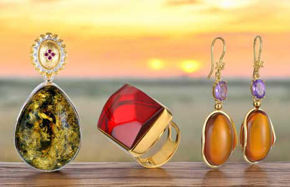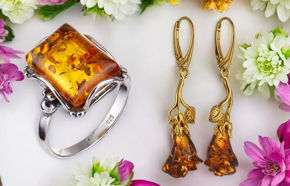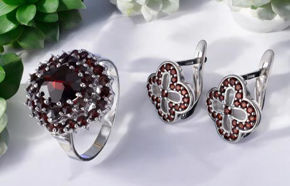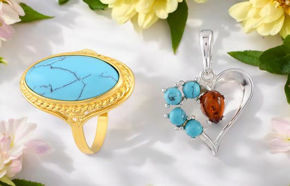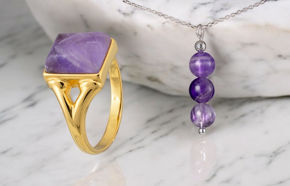FAQ
What does the amber ring symbolize? |
The amber ring is a powerful symbol of protection, warmth, and healing. In many cultures, amber is thought to hold the energy of the sun, positivity, and clarity. It’s also grounding and balancing, negative energy, and good fortune. It’s emotional support, so a great choice for those who need comfort and reassurance during tough times. As a piece of jewelry, an amber ring is a beautiful accessory and holds deep meaning for the wearer. |
| ° |
How can you tell if an amber ring is real? |
| To determine if an amber ring is real, there are several tests you can perform. First, examine the ring under a bright light; genuine amber often has a warm, translucent glow, while imitation materials may appear overly bright or artificial. Next, you can perform a simple scratch test; real amber is relatively soft and won't scratch easily, whereas harder materials may show signs of scratching or damage. Additionally, you could do the "saltwater test": dissolve some salt in water and then place the amber in the solution. Real amber will float, while many fakes will sink. Finally, consider the price and seller's reputation; if the deal seems too good to be true, it likely is. |
| ° |
Is amber an expensive gem? |
| Amber is considered a semi precious gemstone not a precious one like diamonds or emeralds. Price can vary greatly depending on quality, clarity, colour and age. Common amber is relatively cheap but high quality amber especially with unique inclusions or deep rich colour can be more expensive. Prices can range from a few dollars for small not so good quality to hundreds or thousands for larger and rarer ones. Also the market for amber is affected by authenticity, genuine Baltic amber is more sought after. Overall while amber can be expensive under certain conditions it’s often available to many. |
| ° |
What are the benefits of amber rings? |
Amber is more than just pretty. One of the biggest benefits is the healing properties. Many people believe that wearing amber can help with pain, especially from arthritis or teething in children as it’s thought to release succinic acid which is anti-inflammatory. Also amber is associated with calmness and emotional balance so it’s a popular choice for those who want to reduce stress and anxiety. The natural uniqueness of amber means no two rings are the same so you’ll have a one of a kind piece that’s you. And amber rings are light and comfortable to wear daily. |
| ° |
What does amber mean spiritually? |
| Spiritually amber is a protector and healing stone. Its grounding energy connects to the Earth and brings stability and balance to your life. Many spiritual workers consider amber a catalyst for emotional healing as it absorbs negative energy and transmutes it into positive. This is great for people who want to release past traumas or emotional blockages. Amber is also for clarity of thought and connection to your higher self, making it a great tool for meditation and spiritual growth. The warm sunny colors also bring feelings of positivity, vitality, and creativity and a sense of harmony and joy in life. |
| ° |
Why do people wear amber? |
| We wear amber for many reasons, mostly because of its beauty, healing properties(not scientifically proven), and spiritual significance. The colors and inclusions in amber make it a great choice for jewelry so we can express ourselves. Beyond that many believe amber has therapeutic properties, it can help with physical discomfort like arthritis or teething in children. Its grounding energy is thought to bring emotional balance and clarity so it’s popular with those who want mental peace. The idea of wearing a protective stone adds a spiritual layer, people feel empowered by its supposed ability to turn negative energy into positive energy and overall well-being. So amber is a meaningful accessory that’s beautiful and holistic. |
| ° |
Can you get amber ring wet? |
| When it comes to caring for amber rings, you need to consider its water and moisture sensitivity. Amber is a hard gemstone but it’s porous so prolonged exposure to water can affect its appearance and integrity. Getting an amber ring wet occasionally like when you wash your hands is not a problem but it’s best to avoid submerging it in water for extended periods like in the bath or swimming. Exposing it to harsh chemicals like those found in cleaning agents can also damage the surface of the amber. To keep the ring looking its best and longest, it’s best to remove it when you’re in activities that involves water. Gentle cleaning with a soft cloth can help preserve the shine without risking water damage. |
| ° |
How much is amber worth? |
| The worth of amber varies widely, influenced by several key factors including quality, clarity, color, and age. Generally, common amber can be relatively inexpensive, often available for just a few dollars, while high-quality pieces that exhibit rare characteristics such as distinct inclusions or vibrant colors can fetch hundreds or even thousands of dollars. Authenticity plays a significant role in determining value; for instance, genuine Baltic amber is particularly sought after, thereby commanding higher prices. Additionally, market trends and consumer interest can fluctuate, affecting overall valuation. Hence, while affordable options exist, collectors and connoisseurs may find themselves investing significantly in premium specimens. |
| ° |
How long does amber jewelry last? |
| Amber can last for years, even generations if you take care of it. Amber is a pretty durable material but softer and more porous than diamonds or sapphires. So it can get scratched or damaged if not handled with care. To keep it going, store amber jewelry away from harsh chemicals and extreme temperatures as they will affect the appearance. Clean with a soft dry cloth regularly and you can enjoy wearing amber jewelry for a long time and appreciate its beauty and benefits over time. |
| ° |
What is the rarest color of amber? |
Blue amber is the rarest of all and collectors and gem lovers go crazy for it. Unlike the more common yellows, oranges and browns of amber, blue amber has a unique and mesmerizing colour that can go from pale blue to deep blue and is often translucent. This colouration is due to specific environmental conditions during its formation and the presence of certain organic compounds. Found mainly in the Dominican Republic, blue amber is expensive and is used in high end jewellery so if you own one you are one of the lucky ones. Its rarity and beauty make it stand out from the common ambers. |
| ° |
Is amber more valuable than diamond? |
When comparing amber to diamonds, you need to consider all the factors that affect their value. Some high quality amber can be very valuable, especially blue amber or amber with unique inclusions, but diamonds are generally more valuable. Diamonds are more sought after because of their hardness, brilliance and established status as a luxury and symbol of importance in engagement and high end jewelry. The diamond market is very structured with clear grading systems for cut, clarity, color and carat weight that drives up the price. Amber’s value is more variable and subjective, influenced by size, color and historical significance rather than a grading system. So while amber can command high prices, especially for rare types, diamonds are generally more valuable in most cases. |
| ° |
What is the best quality amber in the world? |
| Baltic amber is considered the best quality amber in the world and is known for its clarity, colour and age. Formed from the resin of trees 30 million years ago Baltic amber has a range of colours from golden to cognac and even blue and green. Its high clarity shows unique inclusions such as insects or plant material which can increase its value. Baltic amber is also prized for its smoothness and ability to polish up well. Collectors and enthusiasts like it for its beauty and its history making it the most sought after amber in the world. |
| ° |
Which finger to wear an amber ring? |
When choosing which finger to wear an amber ring, personal preference and cultural significance of each finger comes into play. Many people wear rings on their ring finger as this finger is associated with love and commitment. Wearing an amber ring on the right hand means balance and protection, left hand means spiritual connections. The thumb is also a unique choice as it means independence and personal strength. But ultimately the most important is comfort; you must choose a finger where the amber ring feels comfortable and sits snugly so you can wear it all day. |
| ° |
Can you wear amber every day? |
Yes you can wear amber everyday just take the necessary precautions to make it last. Amber is durable but more prone to scratches and damage than harder gemstones. So remove amber jewelry before doing activities that may expose it to harsh chemicals or rough conditions like cleaning or sports. Also store amber away from extreme temperatures and direct sunlight to preserve its appearance. Gentle cleaning with a soft cloth will keep the amber ring looking its best. By being mindful you can enjoy the beauty and benefits of amber in your daily wear. |
| ° |
Can you wear amber in the shower? |
Don’t wear amber in the shower. Amber is a hard material but it’s porous and can be damaged by moisture and temperature changes. Soap, shampoo and other personal care products can dull the finish of amber and cause discolouration over time. The steam and heat from a hot shower can also damage the amber and cause cracks or a loss of its natural luster. Remove your amber before showering and store it in a dry place when not being worn. |
How can you tell real amber? |
Here are the simple tests:Visual InspectionColor and Transparency: Real amber has unique warm tones, from golden yellows to deep oranges and reds. Genuine amber is transparent or semi-transparent. Fake amber is too perfect or has air bubbles. The Saltwater TestBuoyancy: Mix 1 part salt to 3 parts water and stir well. Drop your amber into the solution. Real amber will float, most imitations and plastics will sink. The Hot Needle TestPine-like Scent: Press a hot needle against a hidden area of the amber. Genuine amber will have a pine-like scent from its organic origins. Plastic or resin will have a chemical smell. Electrification TestStatic Electricity: Rub the amber on a cloth and then hold it next to small particles like paper scraps. Real amber will generate static electricity and attract the particles, a property of amber. UV Light TestFluorescence: Under UV light, real amber will often fluoresce and glow blue or green. Fake amber doesn’t. Consult a ProFor valuable pieces always consult a gemologist or amber expert. They can give you definitive verification and authentication. Now you know how to tell if your amber is real. |
| ° |
Is amber jewelry worth anything? |
Yes, Baltic amber jewelry is worth something, especially in the jewelry world. Baltic amber is famous for its history and beauty, it’s one of the most popular types of amber. The value of your new Baltic amber jewelry can be affected by several factors, color, clarity and skill of craftsmanship. In the jewelry world Baltic amber is highly valued because of its organic origin and the inclusions it contains, ancient insects or plant material. Inclusions can increase the value of the amber. And the fact that your jewelry is new puts it at a premium, because it means it’s not worn, not scratched, not damaged. Collectors and enthusiasts look for high quality Baltic amber for its beauty and health benefits. Since it’s a luxury item you can expect well made pieces to cost reasonably. To get the best price sell your amber jewelry through reputable dealers or specialized auctions where collectors will pay top dollar for genuine pieces. In short, your new Baltic amber jewelry is worth something in the jewelry world, so it’s an investment or a treasure to keep. |
| ° |
Why is amber so expensive? |
Amber, especially Baltic Amber, is highly valued and can be quite expensive due to several key factors. Firstly, rarity and limited geographical availability play a significant role. Baltic Amber is primarily found in the Baltic region, making it a geographically constrained resource. Secondly, its unique and ancient formation process contributes to its high price. Amber is fossilized tree resin, and it takes millions of years to harden and develop its characteristic beauty. This natural and time-consuming process adds to its rarity and value. Thirdly, there is a high demand for Baltic Amber across various industries. It is highly sought after in jewelry making, home decor, and even alternative medicine. This widespread demand naturally drives up its price. The skilled craftsmanship required to work with amber is another important factor. From cutting and polishing to creating intricate designs, working with amber requires a high level of expertise, which also adds to its cost. Lastly, the cultural and historical significance of Baltic Amber elevates its desirability. It has been cherished for centuries, often referred to as "the gold of the sea," and holds a special place in many cultures, further boosting its value. In summary, the combination of its rarity, ancient formation process, high demand, skilled craftsmanship, and cultural significance all contribute to the high cost of Baltic Amber. |
| ° |
What do the amber earrings do? |
Amber earrings are a beautiful and wellness bonus. Handmade from real Baltic amber these earrings are known for their quality and healing properties. Wearing amber earrings can help with headaches, migraines and joint pain because of the amber’s soothing properties. They also have a calming effect that can help reduce stress and anxiety so are a popular choice for those who want a holistic approach to wellness. Lightweight design so comfortable to wear every day and show off one of a kind amber inclusions. Each pair is unique. Also hypoallergenic so suitable for those with sensitive skin or allergies to certain metals. Amber is believed to boost the body’s natural healing, energy and immune system. Available in various styles from classic studs to elegant drops so there’s a pair for everyone who wants to wear style and wellness benefits. |
| ° |
What is the rarest color of amber? |
| When it comes to amber, the rarest and most sought-after color is blue. With only a few known specimens globally, blue amber is a true gem of nature. What sets it apart is its unique ability to change hues under UV light, sometimes appearing to glow green or even red. This fascinating property, known as fluorescence, occurs when light interacts with the organic material within the amber. Blue amber is primarily found in the Dominican Republic, specifically in the Santiago and Cibao regions. Its rarity and stunning visual effects make it highly prized among collectors and gemstone enthusiasts. If you ever come across blue amber, consider yourself fortunate—it’s one of nature’s most extraordinary treasures. |
| ° |
Does real amber float or sink in water? |
| When asked whether real amber floats or sinks in water, the answer is that real amber floats. This buoyancy is particularly evident in saltwater but can also be observed in freshwater. Amber’s ability to float is due to its unique composition and lightweight nature. Unlike minerals, amber is an organic gemstone formed from the fossilized resin of ancient trees. This resin, over millions of years, transforms into the warm, golden material we recognize today. The lightweight property of amber is crucial for its buoyancy. While many gemstones, such as quartz or sapphire, sink in water due to their density, amber stands out by staying afloat. This characteristic is not just a fun trivia fact; it is also a practical method used to authenticate amber. In a marketplace filled with synthetic imitations, the buoyancy test serves as an effective way to distinguish genuine amber from fake counterparts. Amber is also celebrated for its supposed healing properties, adding to its allure in jewelry and decorative items. Its warm appearance and tactile feel make it a sought-after material. Whether worn as a necklace or displayed as a decorative piece, amber continues to captivate with its natural beauty and fascinating properties. |
| ° |
Does real amber float or sink in water? |
| So when asked if real amber floats or sinks in water the answer is real amber floats. This is especially noticeable in saltwater but can be seen in freshwater too. Amber’s ability to float is due to its unique composition and lightweight nature. Unlike minerals amber is an organic gemstone formed from the fossilized resin of ancient trees. That resin over millions of years turns into the warm golden material we see today. The lightweight property of amber is key to its buoyancy. Many gemstones like quartz or sapphire sink in water because of their density but amber stands out by floating. This is not just a fun fact; it’s also a practical way to test amber. In a market full of fake imitations the buoyancy test is a great way to tell real amber from fake. Amber is also said to have healing properties which adds to its appeal in jewelry and decorative items. Its warm look and feel is what makes it so desirable. Whether worn as a necklace or displayed as a decorative piece amber is just so beautiful and interesting. |
| ° |
What color amber is most expensive? |
| Amber, a fossilized tree resin prized for its beauty and history, not all colors are created equal when it comes to value. Green amber is the most expensive. This is due to its rarity and the process of formation, which is often specific to certain conditions. Green amber can range from a subtle greenish tint to a dark forest green and is highly sought after by collectors and jewelers. But other colors like blue amber which glows blue in natural sunlight also command high prices. Yellow and honey amber is more common and therefore less expensive. Clarity, inclusions (fossilized insects or plant material) and overall appearance also play a big role in determining the value of amber. So green is the most expensive but blue can also be pricey depending on the specifics. Collectors be aware. |
| ° |
What is the highest quality amber? |
| When talking about the best amber, Baltic Amber is often the first that comes to mind because of its qualities. Several things determine the quality of amber: Colour is key, high quality amber is pale yellow to dark gold. Clearer, more vibrant colours are more sought after. Translucency is another big factor. Premium amber is clear or has high translucency, light passes through easily. Inclusions can also increase the value of amber. Rare, well preserved inclusions like plant matter, insects or air bubbles add uniqueness. Density is another indicator of quality. Denser amber means older resin that has been fully solidified. Hardness is also important. High quality amber should be hard enough to scratch and not lose its lustre over time. And the smell of amber can also tell you its quality. Authentic amber gives off a faint pine smell when heated, from its organic origin. Putting all these together, Baltic Amber is often the best because of its colour, translucency, inclusions, density, hardness and smell. |
| ° |
Does real amber feel like plastic? |
| When you touch amber it feels like plastic. Here’s what you need to know to tell the real from the fake. Amber is a natural material that has been fascinating humans for centuries. Unlike plastic, real amber has some unique characteristics that make it easy to tell apart. First, amber is lighter and warmer to the touch than plastic which is generally cool. You can feel this warmth immediately when you hold a piece of real amber. One of the most telling signs of real amber is the scent. When heated or rubbed amber gives off an earthy, piney smell, known as the “pinewood” smell. Plastic will give off a chemical smell when heated. Another way to test real amber is the saltwater test. Real amber will float in saltwater, most plastics will sink. Amber can also develop an electrostatic charge when rubbed against fabric, it attracts small particles - the “amber effect” or “electrostatic attraction”. This is not seen in plastic. Under UV light real amber fluoresces, it gives off a blue or greenish glow, plastic doesn’t. Lastly, amber often has inclusions such as small plant matter or insect fossils which makes it unique. These inclusions are not found in plastic imitations. In summary, while there may be some surface similarities, the warmth, scent, electrostatic properties, fluorescence under UV light and unique inclusions of real amber makes it different from plastic. |
| ° |
What is the difference between amber and Baltic amber? |
| Amber and Baltic amber both come from fossilised tree resin but they have some differences to note. Amber is a general term for fossilised resin found all over the world and can be many colours including yellow, brown, green and blue. Baltic amber is specific to the Baltic region and is known for its deep golden colour. One of the main differences is the succinic acid content. Baltic amber has more succinic acid which makes it more valuable especially for its health and wellness benefits. That’s why Baltic amber is highly sought after for therapeutic uses. Inclusions wise, Baltic amber often has small fragments of insects or plants which makes it more unique and sought after by collectors. These inclusions are less common in other types of amber which adds to the allure of Baltic amber. Lastly, the geological age of Baltic amber is 44 million years. That’s relatively younger than other types of amber but gives valuable insights to prehistoric ecosystems. In summary, all amber is cool but Baltic amber stands out for its higher succinic acid content, unique inclusions and golden colour, that’s why it’s a must have for collectors and those who wants its health benefits. |
| ° |
What does natural amber look like? |
| Natural amber is a fossilized resin that has been loved for centuries. It comes in pale yellow to dark brown and everything in between, including golden and deep orange. One of the most magical things about amber is the inclusions – tiny plant or insect particles trapped inside the resin millions of years ago. These inclusions add to the beauty and science. Most natural amber is transparent, some is opaque or translucent. When held up to the light, real amber should glow warm, this is called the “amber effect” or “sun spangle”. This is a key to authenticity. Natural amber is warm to the touch and will float in saltwater, this helps to rule out many imitations. As natural amber ages it can develop a patina or small cracks called sunburst, this is a sign of age and more proof of its authenticity. These are just one of the many reasons natural amber is not only beautiful but also interesting. |
| ° |
What does Amber do when you wear it? |
| When you wear amber, it is believed to provide a range of natural healing benefits. One of the most commonly cited advantages is its ability to relieve pain, making it particularly popular for teething babies and adults suffering from arthritis. This is thought to be due to the release of succinic acid—a compound found in Baltic amber—when it comes into contact with your skin. Succinic acid is reputed to have anti-inflammatory properties that may help alleviate symptoms of conditions like asthma and allergies. In addition to its physical benefits, amber is also said to promote a sense of calmness and reduce anxiety. Many people wear amber jewelry, such as necklaces or bracelets, to help manage stress and improve their overall mood. Anecdotal evidence supports these claims, although scientific research on the subject remains limited and inconclusive. For example, a 2014 study in the "International Journal of Osteoarchaeology" suggested that succinic acid could have anti-inflammatory effects, but more research is needed to confirm its effectiveness in humans. Similarly, a 2018 review in the "Journal of Archaeological Science: Reports" discussed amber's traditional use in medicine, acknowledging its cultural importance but questioning the scientific validation of its health claims. On a personal note, I experienced a noticeable reduction in anxiety levels after wearing an amber necklace for a few weeks. Additionally, a friend reported that her teething baby seemed less fussy and slept better when wearing an amber teething necklace. While scientific evidence is still catching up, many people swear by the benefits of amber, making it a popular choice for those seeking natural remedies to enhance their well-being. |
| ° |
Why do people wear amber jewelry? |
| We wear amber for many reasons, from its beauty to its perceived health benefits and cultural significance. Amber with its warm golden tones is a versatile accessory that suits most skin tones and outfits, so it’s a favourite among fashion conscious people. Beauty aside, amber is also believed to have natural healing properties. Many people wear it to reduce stress and feel good. Historically amber has been used as a teething aid for babies, believed to soothe the pain and inflammation naturally. So it’s a treasured item for parents looking for safe natural solutions for their babies. In many cultures amber is thought to ward off negative energy and provide protection, so it adds another layer of meaning for the wearer. Amber is a fossilised resin from millions of years ago, so it’s got a uniqueness and historical significance that many find cool. Wearing amber jewellery is like carrying a piece of history with you and connecting to ancient times and cultures. In summary, people wear amber jewellery for its beauty, therapy, safety, historical interest and cultural meaning. |
| ° |
How do you take care of Amber jewelry? |
To keep your amber jewelry looking beautiful for years to come here are some tips:Cleaning Methods
Storage Tips
Usage Precautions
By following these tips you’ll be able to keep your amber jewelry looking beautiful and in great condition for years to come. |

